ESP BUICK ROADMASTER 1993 Owners Manual
[x] Cancel search | Manufacturer: BUICK, Model Year: 1993, Model line: ROADMASTER, Model: BUICK ROADMASTER 1993Pages: 340, PDF Size: 18.34 MB
Page 65 of 340
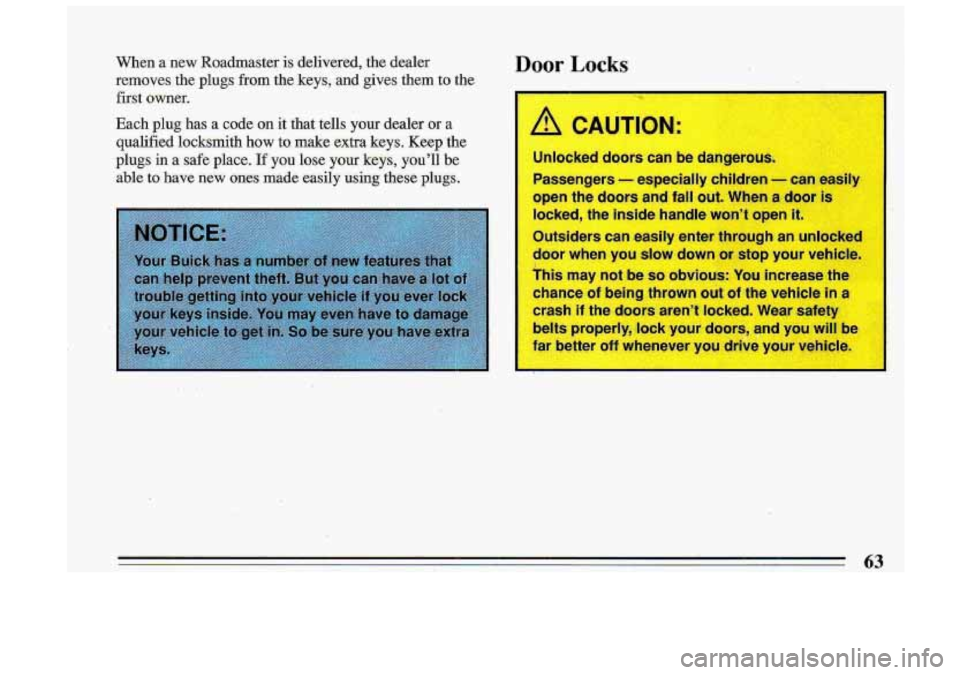
When a new Roadmaster is delivered, the dealer
removes
the plugs from the keys, and gives them to the
first owner.
Each plug
has a code on it that tells your dealer or a
qualified locksmith how to make exBa keys. Keep ‘the
plugs in a
safe place. If y.ou lose your keys, you’ll be
able to have new ones made easily using these plugs.
Door Locks
I
A CAUTION:
Unlocked doors can be dangerou,.
P.assengers
- especially children - can easily
open the doors and fall out. When a.door is
locked, the inside handle won’t open
it. , .,
Outsiders can easily enter through an uniockc
door when you
slow down or stop your vehicle.
?his may not be
so obvious: You increase the
chance of being thrown out of the vehicle
in a
crash if the doors aren’t locked. Wear safetl
belts properly, lock your doors, and you wi’ll be
far better off whenever you drive your vehicle.
,
Page 74 of 340
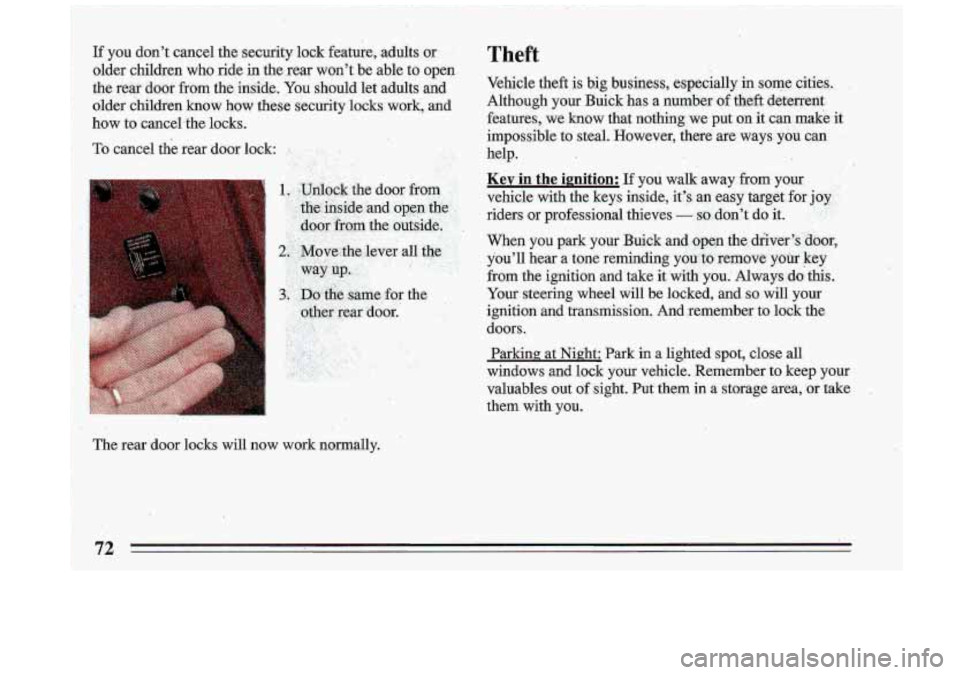
Theft
Vehicle theft is big business, especially in some cities.
Although your Buick has
a number of the€t deterrent
features, we know that nothing we put on it can make
it
impossible to steal. However, there are ways y6U can
help.
Kev in t~he ignition: If you walk away from your
vehicle with the keys inside, it's an easy'target for joy%..
riders or professional thieves - so don't do it. wyqw. .:: %3: F: ;-;.::. *.'%(:.
When you park your Buick and open'the diiver 's'door,
you'll hear a tone reminding you'to remove your key
from the ignition and take it with you.' Always
do this..
Your steering wheel will be locked, and
so will your
ignition and transmission. And remember to lock the
doors.
.. .L: . . *:*.a ;*;,,,
Parking at Night: Park in a lighted spot, close all
windows and lock your vehicle. Remember to keep your
valuables out
of sight. Put them in a storage area, -or take
them with you.
Page 92 of 340
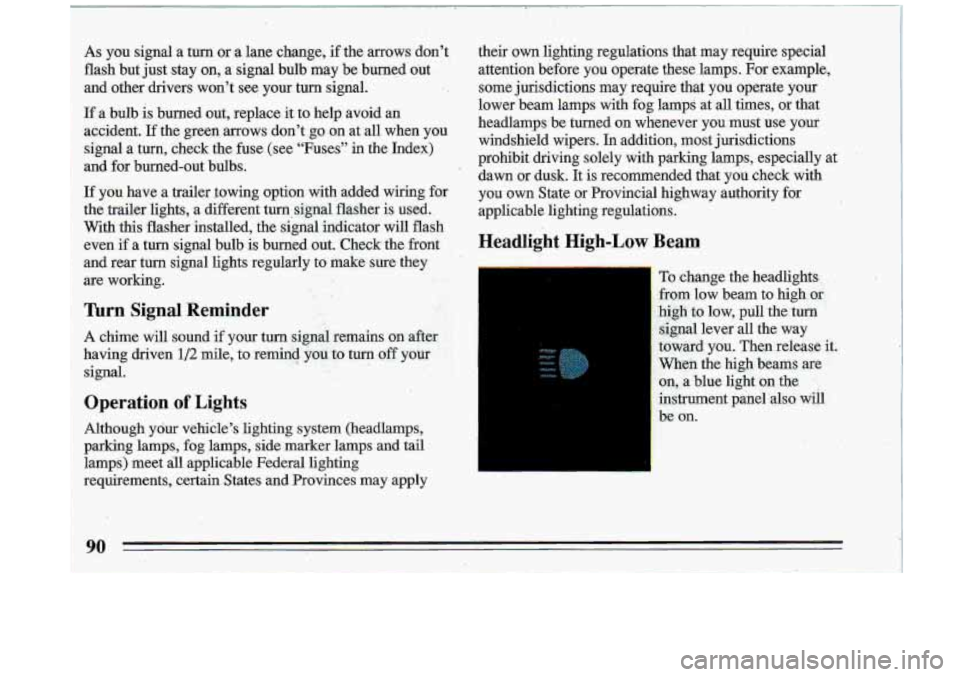
As you signal a turn or a lane change, if the arrows don't
flash but just stay on, a signal bulb may be burned out
and other drivers won't see your turn signal.
If a bulb is burned out, replace it to help avoid an
accident. If the green arrows don't go on at all when you
signal a turn, check the fuse (see "Fuses" in the Index)
and for burned-out bulbs.
If you have a trailer towing option with added wiring for
the .trailer lights, a different
turn signal flasher is used.
With this flasher installed, the signal indicator will flash
even if
a turn signal bulb is burned out. Check the front
and rear turn signal lights regularly to make sure they
are working.
Turn Signal Reminder
A chime will sound if your turn signal remains on after
having driven
1/2 mile, to remind you to turn off your
signal.
Operation of Lights
Although your vehicle's lighting system (headlamps,
parking lamps, fog lamps, side marker lamps and tail
lamps) meet all applicable Federal lighting
requirements, certain States and Provinces may apply their own lighting regulations that may require special
attention before you operate these lamps. For.example,
some jurisdictions may require that you operate your
lower beam lamps with fog lamps at -all times, or that
headlamps. be turned
on whenever you.must use your
windshield wipers. In addition, most jurisdictions
prohibit driving solely with parking lamps, especially at
dawn or dusk. It is recommended that you check with
you own State or Provincial highway authority. for
applicable lighting regulations.
Headlight High-Low Beam
To change the headlights.
l .from low beam to high or..'
:hi:& -to low, pull the turn
signal lever all the way
'toward you. Then .release it.
When the high beams are
on, a blue light, on the
instrument panel -also will
be on.
90
Page 136 of 340
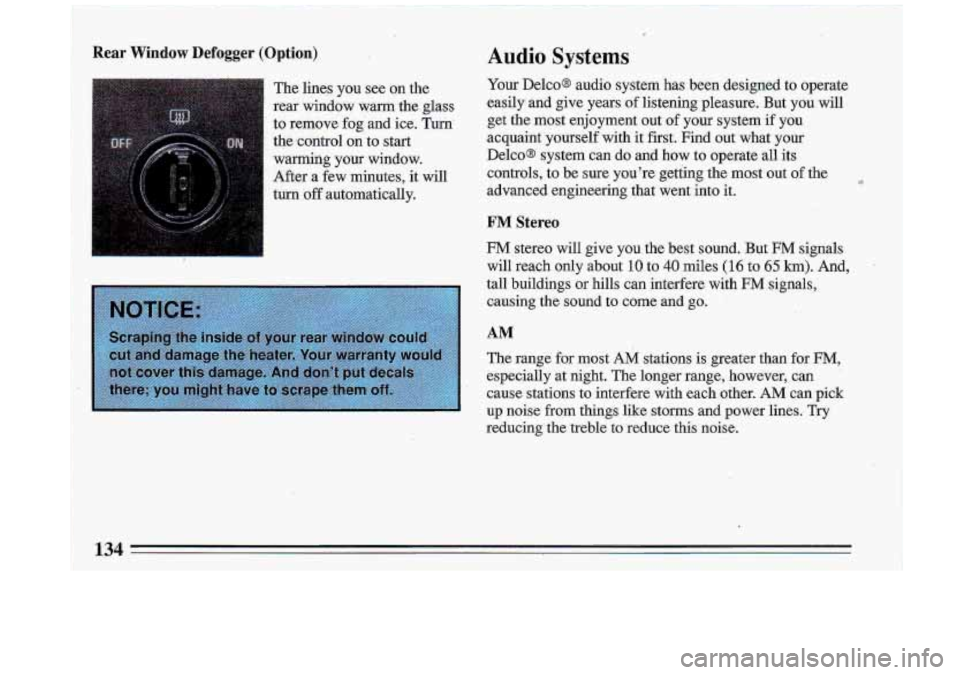
Rear Window Defogger (Option)
The lines you see on the
rear window warm the glass
to remove fog and ice. Turn'
the control on' to start
warming your window.
After
a few minutes; it will
turn off automatically.
Audio Sysxems
Your Delco@ audio system has been designed to uperate
easily and give years
-of listening pleasure. But you will
get the
most enjoyment out of your system if you
acquaint .yourself with it first. Find out what your
Delcos system can do and how to operate all its
controls, to be sure you're getting the most out
sf the
advanced engineering that went into
it.
FM Stereo
FM stereo will give you the best sound. But FM signals
will reach only about
10 to 40 miles (16 to 65 km). And,
tall buildings or hills can interfere with FM signals, causing the
sound to come and go.
AM
The range for most AM stations is greater than for FM,
especially at night. The longer range, however, can
cause stations to interfere with each other.
AM can pick
up noise from things like storms and power lines. Try
reducing the treble
to reduce this noise.
Page 139 of 340
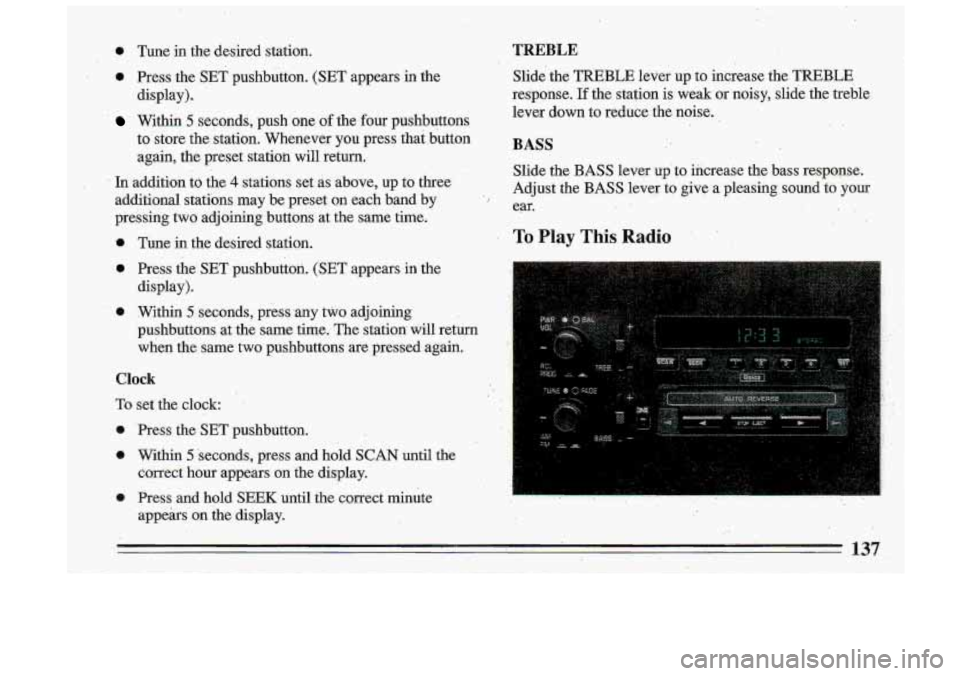
e Tune in the desired station.
0 Press the SET pushbutton. (SET appears in the
display)
..
Within 5 seconds, push one of the four pushbuttons
to.store the- station. Whenever you press that button
again, the preset station will return.
In addition
to the 4 stations set as above, up to three
additional stations may be preset on each band by
pressing two adjoining buttons at the same time.
T.REBLE
Slide. the TREBLE lever up to increase the TREBLE.
response.
If the station is weak or noisy, slide the treble
lever
down to reduce the noise.
BASS
Tune in the desired station.
0 Press the SET pushbutton. (SET appears in the
display).
e Within 5 seconds, press 'any two adjoining
pushbuttons at the same time. The station- will return
when the. same two pushbuttons are pressed again.
Clock '.'
To set the clock:
0 'Press the SET pushbutton.
0 Within 5 'seconds, press and hold SCAN until the
correct hour appears on the display. Slide the
BASS lever up-to increase the bass response.
Adjust the
BASS lever to give a pleasing sound to your
ear. I
To Play This Radio
o Press and hold SEEK until the correct minute . :, ,,,~ . - ., _..^. , , I
appellss on the display. .- I
137, i
Page 141 of 340
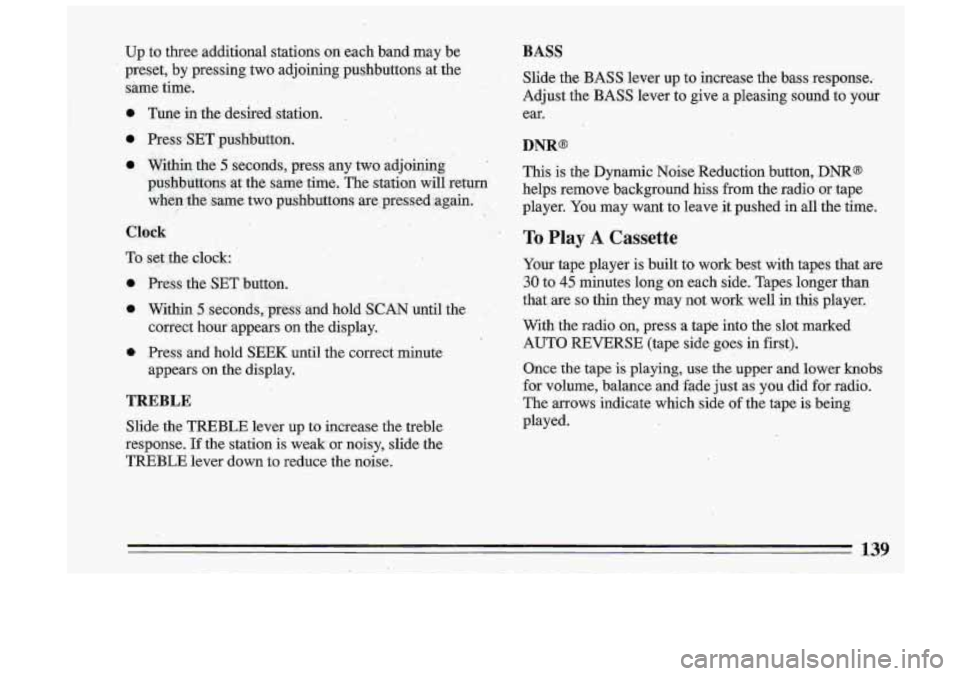
up to three additional stations on each band may be
preset, by pressing two adj.oining pushbuttons at the
sitme time.
TREBLE
Slide the.TREBLE lever up to increase the trewe
response.
If the station is weak or noisy, slide the
TREBLE lever down to reduce the noise.
BASS
Slide the BASS.lever up to increase the bass response.,
Adjust the
BASS lever to give a pleasing sound to your
ear.
DNR@
This is the Dynamic Noise Reduction button, Dm@
helps remove background hiss from the radio or tape
player. You may want to leave it pushed in all the time.
To Play A Cassette
Your tape player is built-to work best with tapes that are
3.0 to 45 minutes long on each side. Tapes longer than
that, are
so thin they may not. work well in this player.
With the radio on, press
.a ta#e into the slot marked
AUTO REVERSE (tap~e side goes in first).
Once the tape is playing, use the upper and lower knobs
for volume, balance and fade just
as you did for radio.
The arrows indicate which side
of the tape is bein,g
played.
139
Page 165 of 340
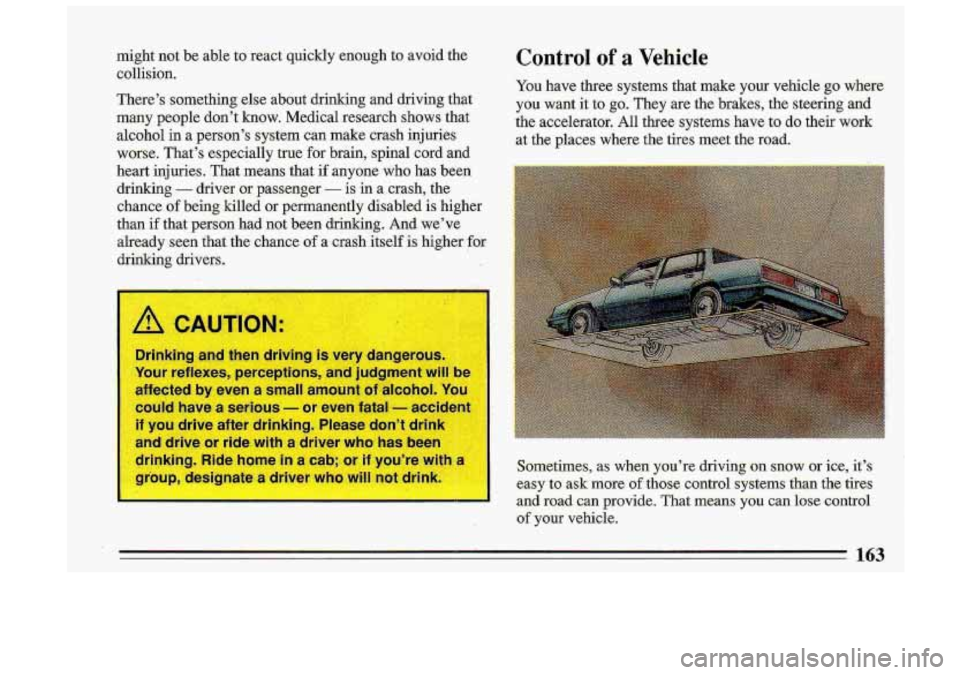
might not be able to react quickly enough to avoid the
collision.
There’s something else about drinking and driving that
many people don’t know. Medical research shows that
alcohol in a person’s system can make crash injuries worse. That’s especially true for brain, spinal cord and
heart injuries. That means that
if anyone who has been
drinking
- driver or passenger - is in a crash, the
chance of being killed or permanently disabled is higher
than
if that person had not been drinking. And we’ve
already-seen that the chance
of a crash itself is higher for
drinking drivers.
1- -
/q CAUTION:
Drinking and then driving is very dangerous.
Your reflexes, perceptions, and judgment
will be
affected by even a small amount
04 alcohol. You
could have a serious - or even fatall - accident
if you drive after drinking. Please don’t drink
and drive or ride with a driver who has been
drinking. Ride home
in a cab; or if you’re with a
group, designate a driver who will not drink.
Control of a Vehicle
You have three systems that make your vehicle go where
you want it to
go. They are the brakes, the steering and
the accelerator. All three systems have to
do their work
at the places where the tires meet the road.
Sometimes, as
when you’re driving on snow or ice, it’s
easy to ask more of those control systems than the tires
and road
can provide. That means you can lose control
of your vehicle.
163
Page 177 of 340
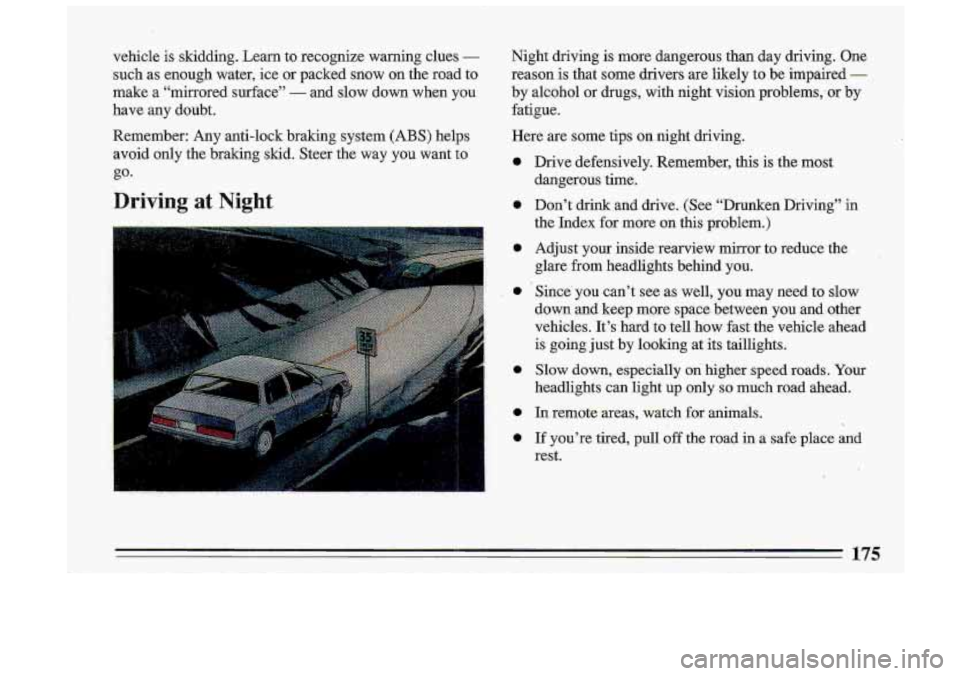
vehicle is skidding. Learn to recognize warning clues -
such as enough water, ice or packed snow on the road to
make a “mirrored surface’’
- and slow .down when you
.have any doubt.
Remember: Any anti-lock braking system (ABS) helps
avoid only the braking skid. Steer the way you want
to
go-
Driving at Night
Night driving is more dangerous than day driving. One
reason is that some drivers are likely to be impaired
-
by alcohol or drugs, with night vision prob1ems;or by
fatigue.
Here are some tips on night driving.
0
0
0
0
a
0
0
Drive defensively. Remember, this is the most
dangerous time.
Don’t drink and drive. (See “Drunken Driving.” in
the Index for more on this problem.)
Adjust your inside rearview mirror to reduce the
glare from headlights behind you.
Since’ you can’t see as well,
you may need to slow
down and
keep more space between you and other
vehicles. It’s hard to tell how fast the vehicle ahead
is going just
by looking at its taillights,
Slow down, especially on higher speed roads. Your
headlights can light up only
so much road ahead.
In remote areas, watch for animals.
If you’re tired, pull
off the road in a safe place and
rest.
175
I
.!
I
Page 180 of 340

The heavier the rain, the harder it is to see. nven if your
windshield wiper blades are in good shape, a heavy rain
,can make it harder to see road signs and traffid. signals, .
pavement markings, the edge of the road, and even
people walking. Road spray can often be worse for
vision than rain, especially if it
comes frum a dirty road.
So it is wise to keep your wiping equipment in good i.
shape and :keep your windshieklwasher tank filled.
Replace
your windshield' wiper inserts when 'they' show
signs
.of streaking-or missing areas on the windshield, or
when strips
of rubber start to separate from the inserts. Driving,
too fast through large water puddles or even
going through some car washes can cause problems,
too.
The water may affect your brakes. Try to avoid puddles.
But
if you can't, try to slow down before you hit them.
A I
,A CA JTION:
Wet brakes can cause accidents. They won't
work well in a quick stop and may cause pl ng
to one side.
Yo Zould lo! eo - *oI of -- 3
vehicle.
After driving thro
-=-- -i la.,e p-Jdle 0. ,later
a car wash, apply your brake aedal liahtly unt
1 Iur brakes work normal
178
Page 182 of 340
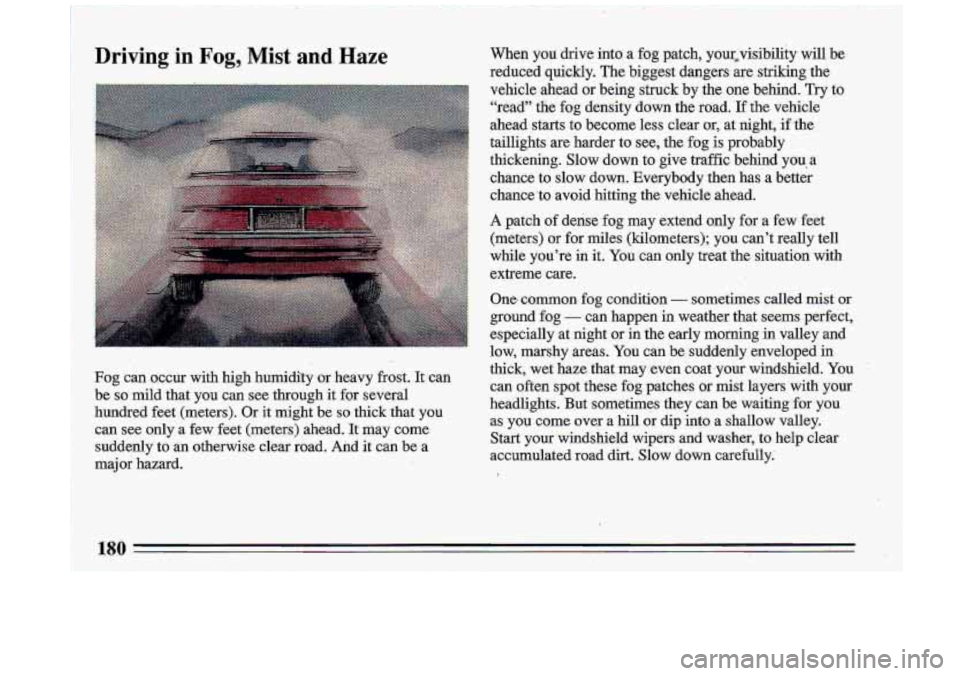
Driving in Fog, Mist and Haze When you drive into a fog patch, your$sibility will be
reduced quickly. The biggest dangers
are striking the
vehicle ahead or being struck by the
one behind. Try to
‘‘read” the fog density down the road.
If the vehicle
ahead starts to become less clear
or, at night; if the
taillights are harder to see,
-the fog is probably
thickening. Slow down to give- traffic behind you. a
chance to slow down. Everybody then has a better chance.to avoid hitting the vehicle ahead.
A patch of derise fog may extend only for a few feet
(meters) or for miles (kilometers); you can’t really tell
while you’re
in it. You can only treat ‘the situation with
extreme tare.
One, common fog condition - sometimes called mist or
ground fog - can happen in weather that seems perfect,
especially at night or in the early
morning in valley and
low, marshy areas. You can be suddenly enveloped
in
thick, wet haze that may even coat ,your windshield. You
can often spot these fog patches .or mist layers with
your
headlights. But sometimes they can be waiting for you
as you come over a hill or dip into a. shallow valley.
Start your windshield wipers and washer, to help clear
accumulated road dirt. Slow down carefully.’
Fog can occur with high humidity or heavy frost. It can
be
so mild that- you can see through it for several
hundred feet (meters). Or-it might
he so thick .that you
can see only
a few feet (meters) ahead. It may come
suddenly
to an otherwise clear road. And it can be a
major hazard.